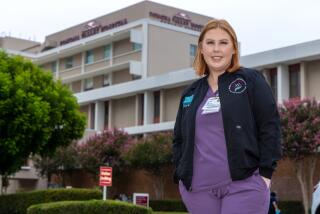YOUR BODY : A Sign of the Times in Health Care . . . the Doctor Extender Is In
- Share via
In the health care industry, they’re known as “doctor extenders” because they provide care that has traditionally been in the physician’s realm.
And as health care costs climb, the ranks of doctor extenders are growing, leaving consumers to wonder: Who is this person? And what is his or her training?
Here’s a rundown of three types of health care professionals you might see the next time you visit a doctor’s office, clinic or hospital.
Physician Assistants
Usually called PAs, physician assistants are always supervised by a doctor and work as a member of the health care team. More than 25,000 physician assistants are in practice nationwide, says Kevin Bayes, spokesman for the American Academy of Physician Assistants in Alexandria, Va.
“In an office setting, a PA would typically do patient histories, complete physical exams, formulate treatment plans, diagnose and order any testing necessary,” Bayes says.
In California, a physician assistant may write an order for medication following guidelines set down by the supervising physician, says Gaye Breyman, a spokeswoman for the California Academy of Physician Assistants.
PAs also work in clinics and hospitals. Exactly where you will find them depends on their specialty. More than one-third of PAs are in family medicine, but others practice in the areas of general surgery, surgery subspecialties, orthopedics, pediatrics, internal medicine, obstetrics and gynecology, and emergency medicine.
PAs are licensed in California. They have generally completed two years or more of college and had previous health-care work experience before enrolling in a PA program, which usually requires another two years. To maintain national certification, a PA must complete 100 hours of continuing education every two years and pass a national recertification exam every six years.
Nurse Practitioners
About 32,000 nurse practitioners are in practice across the country, says Jan Towers, a spokeswoman for the American Academy of Nurse Practitioners in Austin, Texas.
All nurse practitioners are registered nurses with advanced educational training. Today, most programs are at a master’s degree level. Nurse practitioners are state-licensed and nationally certified. They must complete 60 to 75 hours of continuing education and be recertified every three to five years, depending on the requirements of the various recertification organizations.
Typical duties in an office include obtaining a medical history, performing a physical exam, conducting preventive health screens, identifying medical risks and needs, and updating record changes. They also diagnose ailments and develop and implement treatment plans.
In California, nurse practitioners work in collaboration with a physician. They can furnish prescriptions using physicians’ guidelines. In a hospital, Towers says, “They function as house officers. They make rounds and write orders.”
Nurse-Midwives
About 4,500 certified nurse-midwives practice in the United States, says Jim Applebaum, spokesman for the American College of Nurse-Midwives in Washington, D.C. They must graduate from one of 46 accredited educational programs, which include a one-year certificate program or a two-year master’s program. They are state-licensed, and in California must meet continuing education requirements.
Nurse-midwives care primarily for women in low-risk pregnancies. They most often work in hospitals and free-standing birth centers.
In November, the profession received high marks in a survey conducted by Public Citizen’s Health Research Group, which concluded that women who rely on nurse-midwives to deliver their babies are only half as likely to have caesarean deliveries.
In the United States, about one-fourth of babies are delivered by C-section; but the rate drops to less than 12% for births attended by nurse-midwives in hospitals. With nurse-midwives attending, two of three mothers who previously had C-sections delivered without surgery, the survey also found.






